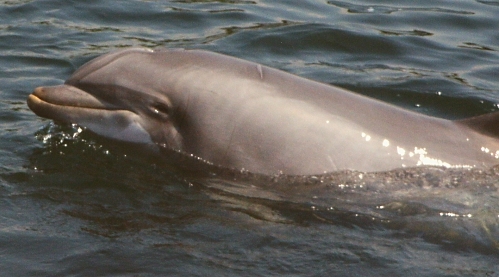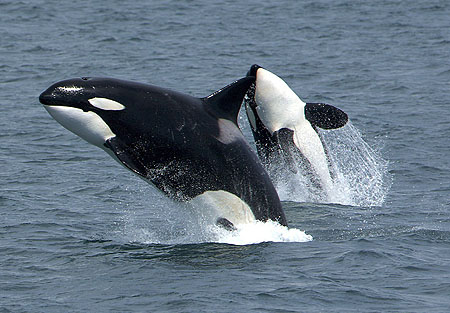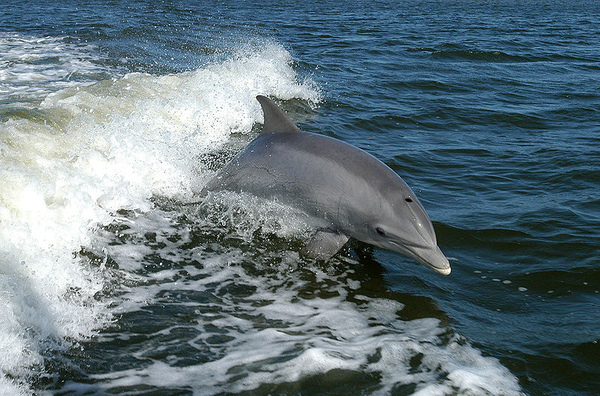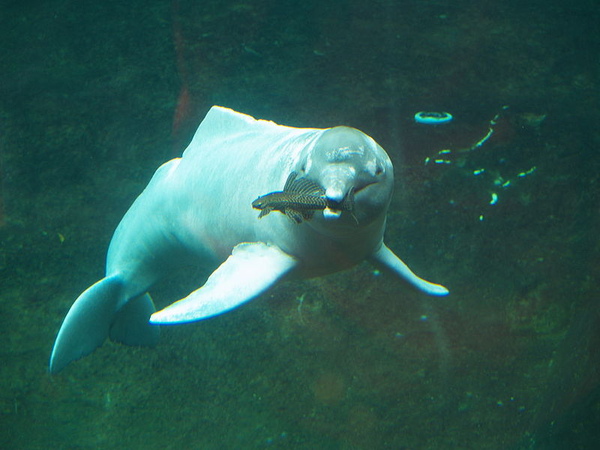海豚/Dolphin
海豚和鯨類(whales)及鼠海豚(porpoises)是近親,都是海中哺乳類動物。
海豚總共有11個屬,共40多種。
海豚的尺寸大小,小至1.2公尺長40公斤重的毛利海豚(Maui's Dolphin),大到9.5公尺長10公噸重的殺人鯨(Killer Whale or the Orca)。
世界各地都能發現他們的蹤跡,特別是在淺水區的大陸棚,他們是食肉性動物,主要的食物是魚和烏賊。
海豚科是鯨目中最大的一個分支,而且是較晚才開始演化的,約從中新世紀開始發展,距今約一千萬年前。
海豚是最聰明的動物,總是友善的出現並帶著嬉戲有趣的態度使得他們備受人類的歡迎。
名字的起源Origin of the name
Dolphin起源自古希臘文的δελφίς(delphís),意思是「有子宮的」,他們名字意謂著「有子宮的魚」。他們的名字delphinus最初經由拉丁文被傳播出去,在中世紀拉丁文稱為dolfinus,舊式法文則稱為daulphin,英文再將ph加入這個字。
Dolphin這個字可以代表幾種不同的意思,它可以指:
à任何海豚科(family Delphinidae)的成員:海洋中的海豚
à任何海豚科(family Delphinidae)及淡水豚總科(family Platanistoidea)的成員:海洋中及河流中的海豚
à任何齒鯨亞目的成員(齒鯨,包括了以上提到的科和一些其它齒鯨類動物)
一般人通常將瓶鼻海豚視為海豚的同義字,因為瓶鼻海豚是最普遍且最為人所熟悉的海豚。
但本文的海豚是指第二種解釋,且不描述鼠海豚(齒鯨亞目,鼠海豚科)。
至於殺人鯨(Orcas or Killer Whale)和一些相近的種類,即使一般口語上稱為「鯨」,但他們確實屬於海豚科,因此被界定為海豚。
而一群海豚,我們通常使用「school」或是「pod」來表示單位。
雄海豚稱為「bulls」,雌海豚則為「cows」,而年幼的海豚一般叫做「calves」。

瓶鼻海豚
海豚的雜交Hybrid dolphins
1933年,有三隻海豚離奇的在愛爾蘭的海灘擱淺,而他們的出現是因為花紋海豚與瓶鼻海豚間的雜種交配。之後,類似的雜種交配在人工飼養的海豚中重複進行,生出了混種的海豚寶寶。
在人工飼養的海豚中,瓶鼻海豚和皺齒海豚(Rough-toothed Dolphin)也能生育出混種的後代。
一般瓶鼻海豚的混種海豚都居住在加州海域,其它混種海豚分布在世界各地,有些是人工飼養,而有些則是野生混種海豚,像是瓶鼻和大西洋斑點圓海豚混種(Bottlenose-Atlantic Spotted hybrid)。
最著名的混種海豚是瓶鼻海豚和偽虎鯨雜交(False Killer Whale-Bottlenose Dolphin hybrid)生育的後代,稱為Wolphin。Wolphin是可以繁殖後代的混種海豚。目前有2頭Wolphin生活在夏威夷的Sea Life Park,第一隻在1985年出生,他的父母是雄性偽虎鯨和雌性瓶鼻海豚。除了人工飼養以外,也曾在野外發現Wolphin的蹤跡。
演化和解剖Evolution and anatomy
演化Evolution
海豚、鯨和鼠海豚都是陸生哺乳動物的後代,最有可能是偶蹄目動物的後代。現今存在海豚的祖先在始新世時期進入海中生活,大約距今5千5百萬年前。
現今海豚的骨骼中有二塊位於骨盆的小型桿狀骨頭,則被認為是退化的後肢。
2006年10月一頭不尋常的瓶鼻海豚在日本被捕獲,在他的生殖裂口二側發現了小鰭,科學家相信這個發現對於「海豚退化後肢」的說法提供了顯著的證據。
解剖Anatomy
海豚擁有極有效率的流線形身體,是為了適應在水中快速游泳。海豚的尾鰭稱為fluke,在游泳時提供推進的力量,而胸鰭和整個尾部則負責控制方向。海豚只有一個背鰭,它主要的功能是當在水中行進時保持穩定。
雖然依種類不同有許多相異的特徵,但基本上,海豚的皮膚通常是深灰色,而且身體下方腹部顏色會比較淺。皮膚上常出現不同顏色及反差很大的線條和斑點。
海豚的頭部有圓型的器官--額隆,額隆的主要的功用是回聲定位。
許多種海豚擁有拉長的下頜,形成一個獨特的嘴喙,例如瓶鼻海豚弧狀彎曲的嘴喙看起來就像一個永恆的微笑。
有些海豚的牙齒多達250顆。
海豚藉由頭上的呼吸孔呼吸;海豚的氣管位於大腦的前方。
海豚的大腦很大且高度的發達,它的結構和大部份的陸上哺乳動物都不相同。
海豚沒有毛髮,但在海豚出生前後,會有少數毛髮圍繞在吻突的尖端,隨即馬上掉落。
唯一有毛髮的海豚是Boto river dolphin,出生後少量的毛髮會持續存在吻突處。
海豚的生殖器官位於身體的底側,雄海豚有2個生殖裂口,1個隱藏陰莖,而另1個在肛門遠處的後方。雌海豚有1個生殖裂口,裂口內有陰道及肛門。另外,雌海豚的乳房裂口位在生殖裂口的2側。
一份由美國海洋哺乳動物基金會發表的研究指出,海豚是除了人類以外唯一會自然形成第二型糖尿病(Type2 Diabetes)的動物,這促使我們更了解這種疾病,並為人類和海豚找出新的治療方法。
感覺官能Senses
不論在海裡或是空氣中,大部分的海豚都擁有敏銳的視力,同時,他們可以聽見頻率比成年人類聽覺上限還要高上10倍或比10倍更高。
雖然海豚頭部的兩側有耳洞,但是一般相信他們在水底下的聽覺能力,除了「耳洞」是「唯一專有」聽覺的器官之外,水底下的聽覺也可以由下頜的震動引導聲音,再經由下頜骨的脂肪腔傳達到中耳完成聽覺的過程。
聽力的另一個功能是回聲定位,這是所有海豚都俱備的能力。
海豚牙齒的功能就像天線,可以接收聽聲音並且精確的指出目標的位置。
海豚的觸覺也十分發達,自由神經末稍密密麻麻的布滿了他們的皮膚,特別是在吻部周圍、胸鰭和生殖器附近。
然而,海豚缺乏嗅覺神經和腦葉,因此一般相信他們並沒有嗅覺。
海豚也擁有味覺,他們表現出對某些種類的魚有特別的喜好。海豚將他們大部分的時間都花在水底,因此對分辬海水味道的就好像陸生動物對空氣的嗅覺一樣重要。在這樣的基礎下,能夠在水中預測出目標存在的器官並不是海豚的嘴巴。
雖然海豚沒有毛髮,他們卻有毛囊可以執行某些感覺功能。長在Boto river dolphin吻突處的微少毛髮,它的功能被認為是為了彌補不良視力的觸覺能力。

殺人鯨
行為Behavior
海豚常被視為地球上最聰明的動物,雖然很難去說明他們到底有多麼聰明。
比較物種的相對智力是十分複雜的,我們可以從不同的感官儀器、反應模式和自然的認知得知。此外,到目前為止,大型水生動物實驗的困難和昂貴已經妨礙了一些測試也限制了其它測試的樣本尺寸和其它嚴苛的條件。然而,比較起許多其它物種,不論是人工飼養的海豚或是野生海豚的行為模式,已經被人類廣泛的加以研究。
社會行為 Social behavior
海豚是群居動物,超過10頭海豚生活在一起。在食物充足的地方,海豚群會暫時的結合,形成一個超過1000頭海豚的超級海豚群(superpod)。
海豚間的溝通透過多變的咔達聲、口哨聲以及其它的發音。他們發出超音速的聲音回聲定位。
海豚群組內每隻海豚扮演的角色不是一成不變的,角色改變是很平常的。然而,海豚群建立非常強且穩固的社會聯結。海豚會待在受傷或生病的同伴身邊幫助他們,如果有需要的話,海豚甚至會協助將他們到水面吸呼。
然而,這種無私行為的出現並不只限於同種類海豚間。在紐西蘭曾觀察到Moko(海豚名,生活在紐西蘭北岸)引導一隻擱淺的雌性侏儒抹香鯨和她的寶寶離開淺海區,這個淺海區已經讓這對母女擱淺很多次了。
他們也曾被目擊,在海中為保護人類免於鯊魚的攻擊而游成迴圈狀,將人類包圍在中間,或是猛烈的攻擊鯊魚讓人類能夠離開。
海豚也展現了他們的文化,這些文化和人類(或其它靈類動物)的文化比較起來,顯得很獨特。在2005年5月,澳洲發現了印度太平洋瓶鼻海豚教導年輕海豚使用工具。在覓食的時候,他們利用海綿掩蔽吻部來保護自己。這方面知識的傳承大部份是由海豚媽媽傳遞給女兒,並不像猿猴靈長類在傳承上並不會因為性別的差異而有所區別。海豚利用海綿當做嘴喙的防護是一種後天學習的行為。在巴西的河豚身上,我們發現另一個經過學習得來的行為,公河豚會用水草和樹枝做為求偶表現的一部分。
海豚對彼此進行攻擊行為。愈年長的雄海豚身上愈有可能覆蓋著更多的咬痕。雄海豚彼此攻擊的原因明顯的和人類一樣:同儕間的競爭和爭取異性的青睬。攻擊的行為愈演愈烈,有時候一方甚至會因為在攻擊行為中落敗而遭到驅逐。
雄性瓶鼻海豚已被發現有擊殺幼豚的行為。我們知道海豚也會殺害鼠海豚,一般而言,鼠海豚的食物和海豚並不相同,因此他們在食物上並不是競爭者,海豚殺害鼠海豚的原因實在無從得知。
繁殖與性行為Reproduction and sexuality
海豚交配時雌雄海豚的腹部是相對的,很多種海豚在交配前會有長時間的前戲,實際上交配的時間卻是短暫的,但是他們可以在短時間內重覆好幾次性行為。
妊娠期的長短因海豚的種類而異,生活在亞馬遜河中小型的Tucuxi海豚妊娠期大約11-12個月,而虎鯨的妊娠期則約17個月。
他們通常在達到性成熟之前就有性行為。性成熟的年齡則視不同種類與不同性別的海豚而有所不同。
海豚進行性交行為的原因並不只是為了繁殖,有時候甚至有同性戀傾向的海豚存在。很多種類的海豚有時候會與不同種類的海豚進行性交行為。
海豚進行性接觸可能是猛烈的。雄海豚有時候對於雌海豚及其它海豚都會表現具攻擊性的行為。
偶爾海豚會與其它動物進行性交,包括人類在內。
食性 Feeding
各式各樣的覓食方法存在於不同種類的海豚和同種海豚之間,有些方法明顯的只專屬於單一族群。魚和烏賊是主要的食物,但是偽虎鯨和虎鯨也食用其它海中哺乳動物。
一種常見的方法是herding,一群海豚迫使大魚群成一個數量較小的餌球,海豚群的成員則輪流如犁田般捕食形成球狀,驚慌失措的魚群。Corralling是一種海豚把追趕到淺水以更容易抓到他們的捕食方法。在南卡羅萊納州,大西洋瓶鼻海豚更進一步的with strand feeding,,將獵物驅趕至泥堆中,使捕食更容易。在某些地方,虎鯨甚至會到海灘捕食海獅。
有些種類的海豚以尾鰭重擊魚類,使用聲納將他們震暈,有時候則將他們擊出水面。
人類與海豚合作捕魚的文獻源自古羅馬作家及自然哲學家老普林尼。現代的人類與海豚合作關係目前在拉古納(大西洋中加那利群島),聖卡塔琳娜州(巴西南部)及巴西。在這裡,海豚將魚群驅趕向漁夫並預示漁夫擲網,而漁夫則在岸邊等待。海豚可以得到的獎賞則是從網中逃脫的魚類。
回聲定位Vocalizations
海豚能夠使用位於吸呼氣孔下方的鼻腔氣囊發出各式各樣的聲音,粗略可概界定出3種聲音:調頻哨聲(frequency modulated whistle)、突發如脈衝的聲音(burst-pulsed sounds)和咔達聲(clicks)。海豚的溝通透過哨聲和突發脈衝聲,雖然他們這種能力的本質和可發揮到何種程度並不被我們所了解。
至少有許多種類的海豚可以使用特定的哨聲來分辨種類間的不同個體。
咔達聲是用來定向和回聲定位,通常他們會發出一小段連串的咔達聲稱為「a click train」。
當海豚接近感興趣的目標物時,咔達聲的速度會增加,而他們用來回聲定位的咔達聲,則堪稱所有海底動物發出的聲音中最響亮的動物。
太平洋斑海豚擊浪Pacific White-Sided Dolphins breaching
海豚偶爾飛躍出水面上,有時候會表演一些技巧高超的精彩動作,如飛旋海豚。科學家至今仍無法確知這些飛躍動作的目的,可能的目的包括了在水面上藉由預兆,如捕食中的海鳥來找出魚群的位置、與其它的海豚溝通、驅逐寄生蟲或是單純的只為了娛樂。
玩耍是海豚文化中很重要的一部份,他們藉由海藻遊戲,並和其它的海豚玩樂打鬧,有時候他們甚至侵擾其它當地的生物,例如海島和海龜。
海豚非常喜歡逐浪,他們經常乘著岸邊的浪花和追逐船隻的船首波(bow waves弓形浪),有時候他們飛躍在行進中雙船體(catamaran)的雙重首波之間。
有時候,海豚也會開玩笑的和游泳者互動。
睡眠Sleeping
一般而言,海豚睡覺時,一次只有1個腦半球處於慢波睡眠,因此可以維持清醒的意識呼吸空氣並觀察可能出現的掠食者或威脅。較早的睡眠階段可以同時發生在2個腦半球。人工飼養的海豚似乎進入全然沉睡的狀態,他們的雙眼緊閉並且對輕微的外部刺激沒有反應,他們的呼吸是自動的,如果必要的話,他們的尾巴會反射性的打水(a tail kick reflex)使呼吸孔保持在水面之上。
海豚的尾巴反射性的打水最初是從麻醉海豚發現的,雖然類似反射性打水的動作曾在鯨香鯨身上發現,但是我們並不知道是否野生海豚也有類似的狀況。
印度江豚的睡眠方式卻與其它海豚種類大不相同,他們生活在水流強勁,且充斥潛在危險的漂浮物之中,勢必不斷的游動身體以避開傷害。因此,印度江豚的睡眠時間非常的短,通常只持續4到60秒的時間。
威脅Threats
自然威脅Natural threats
除了人類(於下文討論),海豚少有天敵。有些種類的海豚或一些特別的族群是沒有天敵的,這使他們成為頂級掠食者,而對大多體型較小的海豚而言,特別是這些海豚的幼豚,潛在的危險只有體型較大的種類,像是公牛鯊(bull shark)、灰色白眼鮫(dusky shark)、虎鯊(tiger shark)和大白鯊(great white shark)。
有些體型較大的海豚,像是虎鯨,也可能獵食其它體型較小的海豚,不過這種情況似乎很罕見。
海豚也受到各式各樣疾病和寄生蟲的侵襲。
人類威脅Human threats
有些種類的海豚面臨多變的未來,特別是一些生活在江河裡的淡水海豚,像是亞馬遜河豚(Amazon River Dolphin)、恆河豚和長江豚(Ganges and Yangtze River Dolphin),都處於危急而嚴重的瀕危狀態。2006年的報告指出,長江豚已經無法再被找到,現今是處於功能性滅絕。
農藥、重金屬、塑膠製品和其它工業和農業污染物不會馬上在環境中迅速分解,但會漸漸的集中在掠食者(predators)身上,這包括了海豚,他們從獵物中得到這些污染物。
因為與船碰撞,特別是船隻的螺旋槳推進器,而導致海豚受傷或死亡是非常常見的。
各種補魚方法都不經意的殺害了許多海豚,最有名的如圍網捕捉金槍魚(seine fishing for tuna)和使用流刺網(drift and gill nets)。流刺網和防止掠食者的魚網(antipredator nets)意外的捕獲在保護海洋漁場是常見的,但卻對當地的海豚族群造成風險。
有些地區如日本的太地町(Taiji)和丹麥的法羅群島(Faroe Islands)在傳統上認為海豚是一種食物,且以魚叉及驅趕漁法(drive hunts)殘害海豚。
海豚肉含有極高的汞,會危害食用者的健康。
海豚安全標籤(Dolphin safe labels)試圖安撫消費者魚魚和其它海中產品的捕殺方式是友善無痛苦的。
在水底下吵雜的噪音,如海軍聲納使用造成的噪音、實彈發射演習或有些海岸邊的建設計劃像是風力發電場,都可能會傷害海豚,增加他們的壓力、損害他們的聽力並迫使海豚為了逃避噪音,太快速的浮到海面上而造成減壓病(decompression sickness)。
以上資料翻譯自維基百科
http://en.wikipedia.org/wiki/Dolphin
Dolphin
Bottlenose Dolphin breaching in the bow wave of a boat.
Dolphins are marine mammals that are closely related to whales and porpoises. There are almost forty species of dolphin in seventeen genera. They vary in size from 1.2 m (4 ft) and 40 kg (90 lb) (Maui's Dolphin), up to 9.5 m (30 ft) and 10 tonnes (9.8 LT; 11 ST) (the Orca or Killer Whale). They are found worldwide, mostly in the shallower seas of the continental shelves, and are carnivores, mostly eating fish and squid. The family Delphinidae is the largest in the Cetacean order, and relatively recent: dolphins evolved about ten million years ago, during the Miocene. Dolphins are among the most intelligent animals and their often friendly appearance and seemingly playful attitude have made them popular in human culture.
Origin of the name
The name is originally from Ancient Greek δελφίς (delphís; "dolphin"), which was related to the Greek δελφύς (delphys; "womb"). The animal's name can therefore be interpreted as meaning "a 'fish' with a womb".[1] The name was transmitted via the Latin delphinus, Middle Latin dolfinus and the Old French daulphin, which reintroduced the ph into the word.
The word is used in a few different ways. It can mean:
Any member of the family Delphinidae (oceanic dolphins),
Any member of the families Delphinidae and Platanistoidea (oceanic and river dolphins),
Any member of the suborder Odontoceti (toothed whales; these include the above families and some others),
Used casually as a synonym for Bottlenose Dolphin, the most common and familiar species of dolphin.
This article uses the second definition and does not describe Porpoises (suborder Odontoceti, family Phocoenidae). Orcas and some closely related species belong to the Delphinidae family and therefore qualify as dolphins, even though they are called whales in common language. A group of dolphins is called a "school" or a "pod". Male dolphins are called "bulls", females "cows" and young dolphins are called "calves".[2]
Hybrid dolphins
In 1933, three strange dolphins beached off the Irish coast; they appeared to be hybrids between Risso's and Bottlenose Dolphins.[3] This mating was later repeated in captivity producing a hybrid calf. In captivity, a Bottlenose Dolphin and a Rough-toothed Dolphin produced hybrid offspring.[4] A Common-Bottlenose hybrid lives at SeaWorld California.[5] Other dolphin hybrids live in captivity around the world or have been reported in the wild, such as a Bottlenose-Atlantic Spotted hybrid.[6] The best known hybrid is the Wolphin, a False Killer Whale-Bottlenose Dolphin hybrid. The Wolphin is a fertile hybrid. Two Wolphins currently live at the Sea Life Park in Hawaii; the first was born in 1985 from a male False Killer Whale and a female Bottlenose. Wolphins have also been observed in the wild.[7]
Evolution and anatomy
Dolphins, along with whales and porpoises, are descendants of terrestrial mammals, most likely of the Artiodactyl order. The ancestors of the modern day dolphins entered the water roughly fifty million years ago, in the Eocene epoch.
Modern dolphin skeletons have two small, rod-shaped pelvic bones thought to be vestigial hind limbs. In October 2006 an unusual Bottlenose Dolphin was captured in Japan; it had small fins on each side of its genital slit which scientists believe to be a more pronounced development of these vestigial hind limbs.[8]
Anatomy
Dolphins have a streamlined fusiform body, adapted for fast swimming. The tail fin, called the fluke, is used for propulsion, while the pectoral fins together with the entire tail section provide directional control. The dorsal fin, in those species that have one, provides stability while swimming.
Though it varies per species, basic coloration patterns are shades of grey usually with a lighter underside, often with lines and patches of different hue and contrast.
The head contains the melon, a round organ used for echolocation. In many species, elongated jaws form a distinct beak; species such as the Bottlenose have a curved mouth which looks like a fixed smile. Some species have up to 250 teeth. Dolphins breathe through a blowhole on top of their head. The trachea is anterior to the brain. The dolphin brain is large and highly complex and is different in structure from that of most land mammals.
Unlike most mammals,
dolphins do not have hair, except for a few hairs around the tip of their rostrum which they lose shortly before or after birth.[9] The only exception to this is the Boto river dolphin, which has persistent small hairs on the rostrum.[10]
Dolphin’s reproductive organs are located on the underside of the body. Males have two slits, one concealing the penis and one further behind for the anus. The female has one genital slit, housing the vagina and the anus. A mammary slit is positioned on either side of the female's genital slit.
A recent study at the US National Marine Mammal Foundation revealed that dolphins are the only animals other than humans that develop a natural form of Type 2 Diabetes, which may lead to a better understanding of the disease and new treatments for both humans and dolphins.[11]
Senses
Most dolphins have acute eyesight, both in and out of the water, and they can hear frequencies ten times or more above the upper limit of adult human hearing.[12] Though they have a small ear opening on each side of their head, it is believed that hearing underwater is also if not exclusively done with the lower jaw, which conducts sound to the middle ear via a fat-filled cavity in the lower jaw bone. Hearing is also used for echolocation, which all dolphins have. It is believed that dolphin teeth function as an antenna to receive incoming sound and to pinpoint the exact location of an object.[13] The dolphin's sense of touch is also well-developed, with free nerve endings densely packed in the skin, especially around the snout, pectoral fins and genital area.
However, dolphins lack an olfactory nerve and lobes and thus are believed to have no sense of smell.[14] They do have a sense of taste and show preferences for certain kinds of fish. Since dolphins spend most of their time below the surface, tasting the water could function like smelling, in that substances in the water can signal the presence of objects that are not in the dolphin’s mouth.
Though most dolphins do not have hair, they do have hair follicles that may perform some sensory function.[15] The small hairs on the rostrum of the Boto river dolphin are believed to function as a tactile sense possibly to compensate for the Boto's poor eyesight.[16]
Behavior
Dolphins are often regarded as one of Earth's most intelligent animals, though it is hard to say just how intelligent. Comparing species' relative intelligence is complicated by differences in sensory apparatus, response modes, and nature of cognition. Furthermore, the difficulty and expense of experimental work with large aquatic animals has so far prevented some tests and limited sample size and rigor in others. Compared to many other species however, dolphin behavior has been studied extensively, both in captivity and in the wild. See cetacean intelligence for more details.
Social behavior
Dolphins are social, living in pods of up to a dozen individuals. In places with a high abundance of food, pods can merge temporarily, forming a superpod; such groupings may exceed 1,000 dolphins. Individuals communicate using a variety of clicks, whistles and other vocalizations. They make ultrasonic sounds for echolocation.
Membership in pods is not rigid; interchange is common. However, dolphins can establish strong social bonds. Dolphins will stay with injured or ill individuals, even helping them to breathe by bringing them to the surface if needed.[17]
This altruism does not appear to be limited to their own species however. The dolphin Moko in New Zealand has been observed guiding a female Pygmy Sperm Whale together with her calf out of shallow water where they had stranded several times.[18] They have also been seen protecting swimmers from sharks by swimming circles around the swimmers[19][20] or charging the sharks to make them go away.[21]
Dolphins also display culture, something long believed to be unique to humans (and possibly other primate species). In May 2005, a discovery in Australia found Indo-Pacific Bottlenose Dolphin (Tursiops aduncus) teaching their young to use tools. They cover their snouts with sponges to protect them while foraging. This knowledge is mostly transferred by mothers to daughters, unlike simian primates, where knowledge is generally passed on to both sexes. Using sponges as mouth protection is a learned behavior.[22] Another learned behavior was discovered among river dolphins in Brazil, where some male dolphins use weeds and sticks as part of a sexual display.[23]
Dolphins engage in acts of aggression towards each other. The older a male dolphin is, the more likely his body is to be covered with bite scars. Male dolphins engage in such acts of aggression apparently for the same reasons as humans: disputes between companions and competition for females. Acts of aggression can become so intense that targeted dolphins sometimes go into exile as a result of losing a fight.
Male Bottlenose Dolphins have been known to engage in infanticide. Dolphins have also been known to kill porpoises for reasons which are not fully understood, as porpoises generally do not share the same diet as dolphins and are therefore not competitors for food supplies.[24]
Reproduction and sexuality
Dolphin copulation happens belly to belly and though many species engage in lengthy foreplay, the actual act is usually brief, but may be repeated several times within a short timespan. The gestation period varies per species; for the small Tucuxi dolphin, this period is around 11 to 12 months, while for the Orca the gestation period is around 17 months. They usually become sexually active at a young age, even before reaching sexual maturity. The age of sexual maturity varies by species and gender.
Dolphins are known to have sex for reasons other than reproduction, sometimes also engaging in homosexual behavior.[25] Various species sometimes engage in sexual behavior including copulation with other dolphin species.[25] Sexual encounters may be violent, with male dolphins sometimes showing aggressive behavior towards both females and other males.[25][26] Occasionally, dolphins behave sexually towards other animals, including humans.[27]
Feeding
Various methods of feeding exist among and within species, some apparently exclusive to a single population. Fish and squid are the main food, but the False Killer Whale and the Killer Whale also feed on other marine mammals.
One common feeding method is herding, where a pod squeezes a school of fish into a small volume, known as a bait ball. Individual members then take turns plowing through the ball, feeding on the stunned fish. Coralling is a method where dolphins chase fish into shallow water to more easily catch them.
In South Carolina, the Atlantic Bottlenose Dolphin takes this further with strand feeding, driving prey onto mud banks for easy access.[28] In some places, Orcas come to the beach to capture sea lions. Some species also whack fish with their fluke, stunning them and sometimes knocking them out of the water.
Reports of cooperative human-dolphin fishing date back to the ancient Roman author and natural philosopher Pliny the Elder.[29] A modern human-dolphin partnership currently operates in Laguna, Santa Catarina, Brazil. Here, dolphins drive fish towards fishermen waiting along the shore and signal the men to cast their nets. The dolphins’ reward is the fish that escape the nets.[30][31]
Vocalizations
Dolphins are capable of making a broad range of sounds using nasal airsacs located just below the blowhole. Roughly three categories of sounds can be identified: frequency modulated whistles, burst-pulsed sounds and clicks. Dolphins communicate with their whistles and burst-pulsed sounds, though the nature and extent of that ability is not known. At least some dolphin species can identify themselves using a signature whistle.[32] The clicks are directional and are for echolocation, often occurring in a short series called a click train. The click rate increases when approaching an object of interest. Dolphin echolocation clicks are amongst the loudest sounds made by marine animals.[33]
Pacific White-Sided Dolphins breaching
Dolphins occasionally leap above the water surface, sometimes performing acrobatic figures (e.g. the Spinner Dolphin). Scientists are not certain about the purpose(s) of the acrobatics. Possibilities include locating schools of fish by looking at above-water signs like feeding birds, communicating with other dolphins, dislodging parasites or simple amusement.
Play is an important part of dolphin culture. Dolphins play with seaweed and play-fight with other dolphins. At times they harass other local creatures, like seabirds and turtles. Dolphins enjoy riding waves and frequently surf coastal swells and the bow waves of boats, at times “leaping” between the dual bow waves of a moving catamaran. Occasionally, they playfully interact with swimmers.
Sleeping
Generally, dolphins sleep with only one brain hemisphere in slow-wave sleep at a time, thus maintaining enough consciousness to breathe and to watch for possible predators and other threats. Earlier sleep stages can occur simultaneously in both hemispheres.[34][35][36] In captivity, dolphins seemingly enter a fully asleep state where both eyes are closed and there is no response to mild external stimuli. Respiration is automatic; a tail kick reflex keeps the blowhole above the water if necessary. Anesthetized dolphins initially show a tail kick reflex.[37] Though a similar state has been observed with wild Sperm Whales, it is not known if dolphins in the wild reach this state.[38] The Indus river dolphin has a different sleep method from other dolphin species. Living in water with strong currents and potentially dangerous floating debris, it must swim continuously to avoid injury. As a result, this species sleeps in very short bursts which last between 4 and 60 seconds.[39]
Threats-
Natural threats
Except for humans (discussed below), dolphins have few natural enemies. Some species or specific populations have none, making them apex predators. For most smaller species, only a few larger species of shark such as the bull shark, dusky shark, tiger shark and great white shark are a potential risk, especially for calves. Some of the larger dolphin species such as Orcas may also prey on some of the smaller species, but this seems rare. Dolphins also suffer from a wide variety of diseases and parasites.[citation needed]
Human threats
Some dolphin species face an uncertain future, especially some river dolphin species such as the Amazon River Dolphin, and the Ganges and Yangtze River Dolphin, which are critically or seriously endangered. A 2006 survey found no individuals of the Yangtze River Dolphin, which now appears to be functionally extinct.[40]
Pesticides, heavy metals, plastics, and other industrial and agricultural pollutants that do not disintegrate rapidly in the environment concentrate in predators including dolphin from their prey. Injuries or deaths due to collisions with boats, especially their propellers, are also common.
Various fishing methods, most notably purse seine fishing for tuna and the use of drift and gill nets, unintentionally kill many dolphins.[41] Accidental by-catch in gill nets and incidental captures in antipredator nets that protect marine fish farms are common and pose a risk for mainly local dolphin populations.[42][43] In some parts of the world such as Taiji in Japan and the Faroe Islands, dolphins are traditionally considered as food, and killed in harpoon or drive hunts.[44] Dolphin meat is high in mercury and may thus pose a health danger to humans when consumed.[45]
Dolphin safe labels attempt to reassure consumers that fish and other marine products have been caught in a dolphin-friendly way.
Loud underwater noises, for example resulting from naval sonar use, live firing exercises or certain offshore construction projects such as wind farms may be harmful to dolphins, increasing stress, damaging hearing and causing decompression sickness by forcing them to surface too quickly to escape the noise.[46][47]




 留言列表
留言列表


